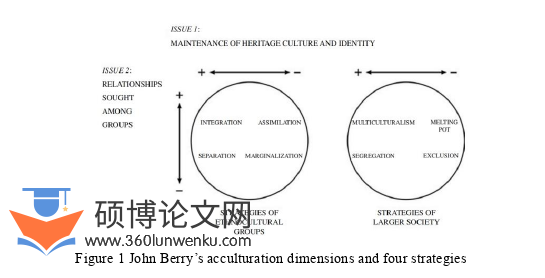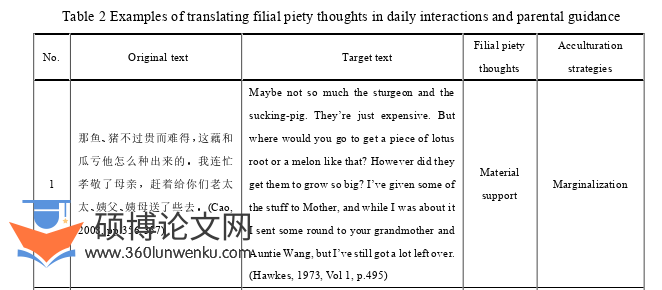本文是一篇英语论文,笔者结合文本细读、文本分析等多种研究方法,本研究解码了霍克斯译本的文化适应策略,分析了这些策略产生的翻译效果,考察其对中国传统文化海外传播的启示。
CHAPTER ONE INTRODUCTION
1.1 Research background
Translation serves as a crucial tool for cross-cultural communication, which not only involves the conversion of language but also the transmission and interpretation of cultural values (Xu, 2002, p.223). In this context, cross-cultural translation faces a dual challenge: ensuring linguistic accuracy while preserving the cultural connotations of the original text. This challenge becomes particularly significant when translating literary works steeped in deep cultural traditions, such as filial piety, a cornerstone of Confucianism and traditional Chinese ethics. The translation of filial piety is not just a linguistic task, but a complex process of conveying a set of values, behaviors, and ethical norms that have profoundly shaped Chinese society for millennia.
Filial piety is not merely an abstract value but is deeply embedded in daily practices and behaviors. Confucius emphasizes that caring for parents involves not only meeting their needs but also showing inner respect. The respect to parents is evident in Confucius’ remark “the filial piety nowadays means the support of one’s parents. But dogs and horses likewise are able to do something in the way of support; without reverence, what is there to distinguish the one support given from the other?” (Confucius, 1971, p.6) Beyond daily care, filial obligations continue even after parents’ death through rituals such as mourning ceremonies and ancestor worship, which reinforce the reverence during lifetime. As Confucius stated, “That parents, when alive, be served according to propriety; that, when dead, they should be buried according to propriety; and that they should be sacrificed to according to propriety” (Confucius, 1971, p.6). This highlights the enduring bond between the living and the deceased in filial piety.
.......................
1.2 Research questions and methodology
The theoretical framework of this thesis draws on John Berry’s Acculturation Theory, which categorizes acculturation strategies into four dimensions: integration, separation, assimilation, and marginalization. This framework serves as a basis for analyzing the impact of translating filial piety culture on cross-cultural communication. By analyzing Hawkes’ translation practices, this study aims to provide theoretical insights into cultural translation and to propose new pathways for evaluating the transmission of traditional Chinese values in cross-cultural contexts. This study aims at addressing three primary research questions:
First, what acculturation strategies can be identified in David Hawkes’ translation of different aspects of filial piety (thoughts, behaviors, and rituals) in Hong Lou Meng?
Second, how effectively do the identified acculturation strategies convey the essence of filial piety culture?
Third, what enlightenment can be drawn from the acculturation strategies and their effectiveness in Hawkes’ rendition of Hong Lou Meng to enhance the cross-cultural dissemination of traditional Chinese values?
These questions aim to explore the translation of filial piety in Hong Lou Meng through a progressively structured approach. The first question examines the acculturation strategies in Hawkes’ rendition of filial piety, identifying tendencies in the application of acculturation strategies. The second question evaluates the effectiveness of these strategies, analyzing how different approaches influence the representation of filial piety in translation. Finally, the third question assesses the enlightenment of Hawkes’ translation on the cross-cultural transmission of traditional Chinese values, particularly on Western readers’ understanding and recognition of filial piety. These questions constitute a framework for analyzing how filial piety, as the core value of Chinese culture, is preserved and adapted in Hawkes’ translation.
.....................
CHAPTER TWO LITERATURE REVIEW
2.1 Studies on the translation of filial piety culture
Filial piety, a core value deeply embedded in traditional Chinese culture, has garnered significant attention in Chinese-English translation studies. Research on the translation of filial piety culture primarily addresses three key areas: translation strategies and translator behavior, the cross-cultural communication and reception of filial piety, and the application of diverse translation theories, including philosophical perspectives.
First, the strategies or methods for the translation of filial piety culture. Research on the translation of filial piety, particularly in classical Chinese texts like The Classic of Filial Piety (《孝经》) and The Analects of Confucius (《论语》), highlights the importance of translation strategies and translator behavior. Jin Qibin (2024) argues that translating “xiao” (孝) requires balancing linguistic accuracy with cultural adaptation to ensure that the concept is accessible to foreigners. Lu Yun and Peng Xue (2024) focus on how translators’ cultural backgrounds and ideologies influence their translation choices, especially in versions of The Classic of Filial Piety translated by Roger T. Ames. Huang Qinli and Wu Shuang (2022) emphasize that translators’ subjective interpretations influence how filial piety is presented, with some prioritizing the preservation of cultural meaning while ensuring the text remains accessible to the target readers. Overall, these works underscore the critical role of translator behavior in conveying the cultural essence of filial piety across languages.
Second, the cross-cultural communication and reception of filial piety. The reception of filial piety outside China has been a key area of study, particularly in how this Confucian value is perceived and interpreted in different cultural contexts. Liu Yue (2025) examines how filial piety in Hong Lou Meng is transmitted through English translations, focusing on how different translators (Hawkes, Bond, and Yang) adapt the concept to target readers. Hawkes emphasizes readability, Bond maintains a more literal translation, and Yang balances fidelity with fluency. Zhao Ting (2023) compares how filial piety is conveyed in PiPa Ji, focusing on the transmission and cultural adaptation of filial piety within Western interpretations of the opera. Additionally, Bai Junfang and Wilt L. Idema (2009) discuss the Western reception of filial piety, particularly through Chinese Buddhism, and how it is perceived in academic settings, highlighting the challenges of reconciling Eastern and Western values. These studies show that while filial piety remains a central value in Chinese culture, its transmission across cultures requires adaptation. Translators and scholars face the challenge of preserving its original meaning while making it accessible to foreign readers, a process that reflects broader cross-cultural negotiations.
....................
2.2 Studies on the translation of Hong Lou Meng
Hong Lou Meng, regarded as the pinnacle of classical Chinese literature, has been taken as the subject of extensive scholarly analysis, particularly regarding the translation of its cultural elements into English. These cultural elements can be broadly categorized into three main areas: traditional culture, material culture, and lifestyle-related culture. This chapter reviews the existing literature on each of these categories, while also highlighting a significant underexplored area, particularly the insufficient focus on the translation of filial piety.
First, traditional cultural and moral elements in Hong Lou Meng, such as literary expressions, festival customs, and social rituals, have received considerable academic attention. Scholars like Liu Xueqin (2001) explored the translation of couplets and poetry, while Dang Qingsheng (2015) focused on translating etiquette and folk culture. Zhu Lin and Wang Nuyi (2023) studied the translation of opera culture, and Wang Yin (2023) examined the translation of two-part allegorical sayings. These studies generally emphasize the importance of balancing cultural specificity with the readability and acceptability of the translation when dealing with traditional cultural elements.

英语论文怎么写
..........................
CHAPTER THREE THEORETICAL FRAMEWORK.............................16
3.1 An introduction to Acculturation Theory ............................... 16
3.2 John W. Berry’s Acculturation Theory ........................................... 19
3.3 The application of Berry’ theory to translation studies ................................. 21
CHAPTER FOUR AN ANALYSIS OF HAWKES’ TRANSLATION OF FILIALPIETY FROM THE PERSPECTIVE OF ACCULTURATION THEORY ................... 23
4.1 Acculturation strategies in translating filial piety thoughts ..................... 23
4.1.1 Translation of filial piety thoughts in daily interactions ................... 24
4.1.2 Translation of filial piety thoughts in royal affairs ................. 31
CHAPTER FIVE CONCLUSION ......................76
5.1 Major findings ............................................ 76
5.2 Limitations ................................... 77
CHAPTER FOUR AN ANALYSIS OF HAWKES’ TRANSLATION OF FILIAL PIETY FROM THE PERSPECTIVE OF ACCULTURATION THEORY
4.1 Acculturation strategies in translating filial piety thoughts
In Hong Lou Meng, filial piety thought is primarily conveyed through three key aspects: daily interactions, such as younger generations showing respect to elders and Jia Zheng’s guidance of Baoyu; royal affairs, exemplified by Yuanchun’s homecoming visit; and mourning rituals. These three aspects collectively reflect the underlying principles of filial piety thoughts.
Yuanchun’s homecoming epitomizes filial devotion within a highly ritualized and respectful background. Her father, Jia Zheng, expresses profound gratitude to the emperor for permitting daughters to visit their parents, underscoring the social and familial expectations tied to filial piety. This event reflects the values of loyalty and respect, highlighting how filial piety serve the hierarchy of the ruler. Similarly, Jia Zheng’s efforts to instill responsibility and respect in Baoyu illustrate the tension between personal desires and broader filial duties. Baoyu’s ambivalence toward these teachings reveals the conflict between individualism and the deep-rooted cultural values of filial piety, a recurring theme in the novel. Besides, some familial occasions can reflect certain filial thoughts. This chapter will employ John Berry’s acculturation framework to analyze Hawkes’s translation of filial piety thoughts in daily interactions, royal affairs and mourning rituals.

英语论文参考
..........................
CHAPTER FIVE CONCLUSION
5.1 Major findings
First, in terms of filial piety thoughts and behaviors, cultural assimilation and integration strategies are often adopted by Hawkes in the translation. This is because there are some commonalities in the conceptual and pragmatic meanings between Chinese and Western values. For example, in daily interactions and family education scenes related to filial piety, when there are overlapping pragmatic values like the bond family affection, integration strategies are used. Besides, deep-rooted Chinese concepts such as “光宗耀祖” are assimilated into more familiar Western notions of family honor. In the translation of Baoyu’s actions showing filial piety, such as giving flowers to elders, the translation sometimes replaces the concept of filial piety with “duty”, which is more understandable to Westerners, but may cause the loss of the unique connotations of filial piety.
Regarding the translation of filial piety rituals, particularly birthday gifts symbolizing filial respect, cultural marginalization and separation strategies are frequently applied. Chinese filial piety rituals are deep-rooted in cultural traditions, characterized by intricate processes and rich symbolism that often differ significantly from Western ritual practices. In the translation of ancestor worship rituals, Hawkes adds annotations to ensure the accurate transmission of ritual connotations and processes. For example, his translation of the “zhao mu” system shows his option for integration strategy, indicating his tendency to preserve the original cultural image. However, this also aligns with the separation strategy, as the translation, while preserving the ritual’s structure and meaning, may overlook the cognitive and cultural background of target readers, thereby limiting their full comprehension. Conversely, when translating complex rituals, the translator may opt to simplify or omit certain cultural details, a clear example of marginalization. This selective adaptation of ritual elements highlights the balance between cultural fidelity and target reader accessibility in translation.
reference(omitted)
